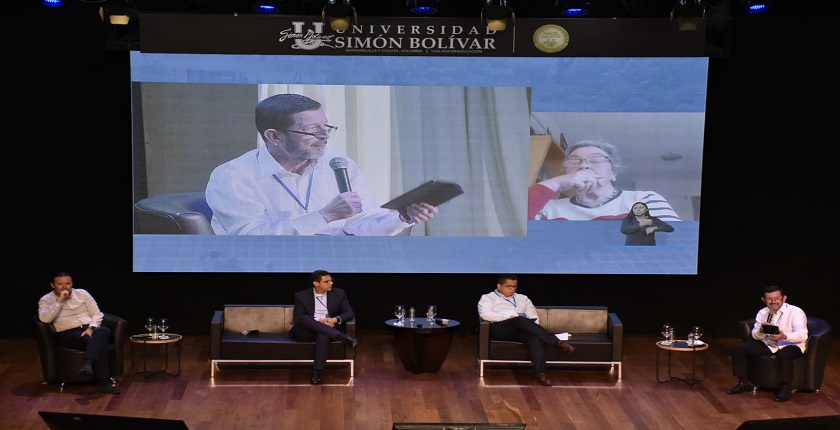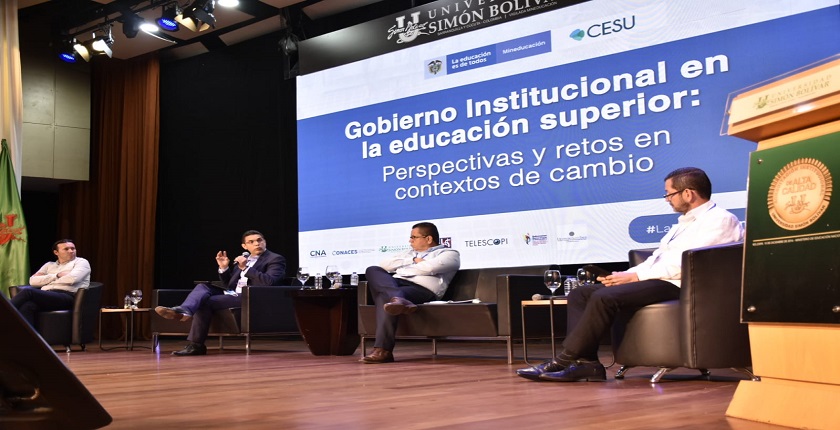Blog
Forum Institutional Government in Higher Education: Perspectives and challenges in contexts of change
- 5 noviembre, 2021

The rector of the María Cano University Foundation and president of the Colombian Association of Higher Education Institutions with Professional, Technological or University Technical Training – ACIET – participated in the Institutional Government Forum in Higher Education: Perspectives and Challenges in Contexts of Change , which took place in the city of Barranquilla, where the National Council of Higher Education – CESU generated a space in which the subject of Institutional Government was reflected on, considering world trends and the Colombian system from a historical and prospective perspective.
It is important to highlight the discussion of four national rectors, who debated the current situation of the educational system in Colombia: Omar Lengerke Pérez, rector of the Santander Technology Units (UTS); Hugo Valencia Porras, rector of the María Cano University Foundation; Jairo Torres Oviedo, rector of the University of Córdoba, and Luis Fernando Gaviria, rector of the Technological University of Pereira; which was also moderated by Mrs. María José Lemaitre, director of the Interuniversity Center for Development.
From this important work for higher education came a conclusive synthesis, generated by Patricia Martínez Barrios and Jairo H. Cifuentes Madrid, which we allow ourselves to quote verbatim:
A good practice in these international forums in higher education is to carry out what we have called a conclusive synthesis.
There are a couple of details about what is not a conclusive synthesis:
– It is not a comprehensive presentation on the subject.
– It is not a summary of the very interesting lectures and panels developed during the Forum.
– It is not a contribution of new and different dimensions on Institutional Government, not dealt with during the Forum.
If the above were tried, we would be lax, and would certainly escape a deep and comprehensive vision of this complex issue such as Institutional Government.
It is, yes, about:
– Make a reflection of what was heard during the Forum.
– Identify some dimensions that should continue thinking, reflecting or studying.
– Of the identification of some strong ideas expressed during the same work.
All this, according to the personal perspective of those who propose them, so that they serve as motivating ideas to continue the conversation on this topic, so pertinent to higher education today.
We will be brief. Baltazar Gracián already pointed out: «the good, if brief, twice as good» (in his work Oracle manual and art of prudence).
From the binomials: institutional government – autonomy, and good governance – quality to a polyhedron that considers complex relationships, with a comprehensive and enriched vision of: autonomy – transparency / social trust – quality – links with interest groups – search for sustainable development – institutional governance.
We start from a fundamental relationship established in recent higher education regulations: good institutional governance – quality.
It is not possible to understand a quality HEI without good governance.
It is necessary to insist and continue structuring good institutional governments that work focused on the fulfillment of the mission, vision and PEI; with policies, norms, planning and sufficient support structures for the achievement of missionary objectives, which offer an adequate balance between academics and management; that they have information systems, effective communication channels with their different stakeholders; with transparent processes and procedures, articulated to an internal quality assurance system, capable of responding with criteria of ethics, efficiency, effectiveness, quality, integrity and transparency. Institutional governments with a participatory approach of their actors and «responders» to the social demands of the environment, with a culture of accountability for their management results and resource management. This is the polyhedron.
The institutional government must listen, achieve empathic listening with the voice of the environment; must adjust, today more than ever, to respond to the demands:
– Of the various interest groups: internal and external.
– On the realities of VUCA environments: volatile, uncertain, complex and ambiguous.
– Of the society in which it is inserted through its multiple forms of conception: third mission, of social projection, of service, of connection with the environment, of social responsibility.
Let us recall here the university trajectory raised by D. Montoya: teaching university, research university and, recently, universities that solve complex problems.
The latter with the challenges of bidirectionality (from the service provider university, to university-society interfecundation) and of «harmonization of missionary functions.»
The role and sense of fiduciary responsibility should be consolidated in the highest collegiate government bodies – MOCG. (From Latin fide, which means loyalty, fidelity).
Understanding the fiduciary duty as the legal and moral responsibility to act exclusively in the best interest of fulfilling the institutional mission, for which the trust of the «Trustee» has been given to the directors; Thus, as “trustees” of that FAITH -TRUST- they are “caretakers” of the educational project entrusted to them, putting the capacities of the trustees at their service, and consequently, the duty to preserve, improve and enhance its social value.
Hence, being or acting as a “trustee” has high demands and duties for the members of the MOCGs and is directly related to institutional sustainability. Institutional governance is not just the responsibility of personal government authority.
The challenges in the MOCGs are: (a) achieving a shared vision, not individual or group interests; (b) the responsibility to rigorously direct institutions in complex environments; (c) prepare to fulfill your responsibilities and evaluate yourself.
In Colombia, HEIs are institutions that continue to appear in surveys as entities that generate trust in society and among young people. Therefore and for this, it has a high responsibility to continue strengthening the pillars of transparency and government with clear rules and procedures for defining the budget and contracting; qualification of internal control and surveillance bodies (good governance and audit committees) and with access to information.
Institutional governments face tensions and challenges in contexts of change, which could be described as follows:
– The definition of the styles of personal leadership and of the governing bodies, according to the characteristics of each institution, recognizing that there is no single profile, but that they are based on values, are experts, respectful of the value of participation, are structured collectively and with a vocation for transformation.
– Balance between executive management and participation in decision-making. In recent decades, we have had strong pressure to transform HEIs into well-managed institutions. These demands have been useful and have provided devices for conducting HEIs seeking effective use of resources. However, in the current times of change, these demands become more complex: it must not only respond to the administrative logic and the interests of the internal bodies, it also requires incorporating the dimension of responsibility and social relevance.
– Balance between efficiency and effectiveness indicators, and benefit and social contribution indicators.
– Balance between autonomy and control (inspection and surveillance); between homogenization and standardization or diversification.
– Balance between effectiveness and legitimacy. Between a managerial model and a socially oriented model. Internal governments that have legitimacy in their communities and among their constituencies-students, teachers, graduates-, but at the same time are effective in promoting permanent changes, «even if it hurts,» as J.J. Brunner
– Balance between flexibility and permanence, between tradition and innovation; between the past, preserving what is essential, and preparing for the future of service to society.
“The university is a living, active, supportive and sustainable institution that has had to respond to the multiple changes in the context – historical, social, cultural, economic and technological – in which it is enrolled, and has managed to survive the most difficult situations without renouncing its nature as an organization focused on knowledge management ”, comprehensive training and service to society. (D. Montoya)
The paradox of adaptability: Dilemma between returning to previous educational models of the crisis, or seeking the development of more inclusive, more relevant and more pertinent educational models that address the new and great challenges: digital transformation, flexibility, flexible trajectories, learning outcomes, interculturality, internationalization through participation in projects and networks to face global challenges and SDGs.
Closing:
There is no single way of conceiving university government, as the panorama of higher education and institutional profiles is diverse, but one issue is clear: there are global and national pressures that demand transformations and changes in the institutions that we must assume in order to maintain the relevance and social value of our HEIs and here the institutional governance is located in a critical and differentiating way.


